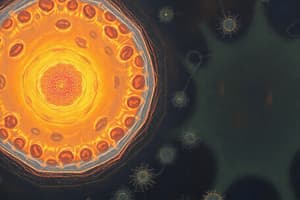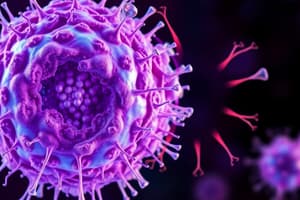Podcast
Questions and Answers
What is the size range of most clinically relevant bacterial species?
What is the size range of most clinically relevant bacterial species?
- 0.05 to 0.5 µm in width and 0.5 to 1 µm in length
- 0.25 to 1 µm in width and 1 to 3 µm in length (correct)
- 0.5 to 5 µm in width and 5 to 10 µm in length
- 1 to 10 µm in width and 10 to 30 µm in length
Which characteristic distinguishes prokaryotic cells from eukaryotic cells?
Which characteristic distinguishes prokaryotic cells from eukaryotic cells?
- Absence of cell walls
- Presence of a defined nucleus
- Presence of plasmids (correct)
- Lack of nucleic acids
What is the significance of the differences in bacterial cell walls?
What is the significance of the differences in bacterial cell walls?
- They determine the replication rate of bacteria
- They influence resistance to antibiotics
- They provide the basis for the Gram stain (correct)
- They determine the metabolic rate of the bacteria
Which of the following options is incorrect about bacterial cells?
Which of the following options is incorrect about bacterial cells?
Which of the following components is NOT typically found in both prokaryotic and eukaryotic cells?
Which of the following components is NOT typically found in both prokaryotic and eukaryotic cells?
Which substance primarily composes the granules that lessen osmotic pressure?
Which substance primarily composes the granules that lessen osmotic pressure?
What is the primary function of polyphosphate granules?
What is the primary function of polyphosphate granules?
Which type of antibiotic interferes with protein synthesis by attaching to the 50S subunit?
Which type of antibiotic interferes with protein synthesis by attaching to the 50S subunit?
What forms the primary genetic material in bacteria?
What forms the primary genetic material in bacteria?
What are gas vacuoles primarily associated with?
What are gas vacuoles primarily associated with?
Which type of granules are also known as Babes-Ernst Bodies?
Which type of granules are also known as Babes-Ernst Bodies?
What is the function of glycogen in bacteria?
What is the function of glycogen in bacteria?
Which of the following is present in the nucleoid of bacteria?
Which of the following is present in the nucleoid of bacteria?
What is a unique characteristic of Mycoplasma regarding its membrane composition?
What is a unique characteristic of Mycoplasma regarding its membrane composition?
Which of the following is NOT a function of bacterial membranes?
Which of the following is NOT a function of bacterial membranes?
Which transport mechanism involves simultaneous transport of two substrates in the same direction?
Which transport mechanism involves simultaneous transport of two substrates in the same direction?
What is a primary advantage of aerobic organisms regarding ion-motive force?
What is a primary advantage of aerobic organisms regarding ion-motive force?
Which type of transport mechanism is characterized by the transport of two like-charged compounds in opposite directions?
Which type of transport mechanism is characterized by the transport of two like-charged compounds in opposite directions?
What role do membranes play in electron transport for aerobic species?
What role do membranes play in electron transport for aerobic species?
Which statement about the housing of enzymes in bacterial membranes is true?
Which statement about the housing of enzymes in bacterial membranes is true?
In which type of transport does a substrate move independent of any coupled ion?
In which type of transport does a substrate move independent of any coupled ion?
What microorganism is known for having a terminal spore?
What microorganism is known for having a terminal spore?
Which property of endospores protects bacteria from human defense mechanisms?
Which property of endospores protects bacteria from human defense mechanisms?
Which type of bacteria is characterized by a subterminal spore location?
Which type of bacteria is characterized by a subterminal spore location?
What method can be used to detect somatic antigens after capsule removal?
What method can be used to detect somatic antigens after capsule removal?
What is a characteristic of the spore protoplast found in endospores?
What is a characteristic of the spore protoplast found in endospores?
In what way does the slime layer differ from a capsule?
In what way does the slime layer differ from a capsule?
Which characteristic is true about the capsule of some bacteria?
Which characteristic is true about the capsule of some bacteria?
What does the spore wall of an endospore contain that is crucial to its function?
What does the spore wall of an endospore contain that is crucial to its function?
What is the main feature that distinguishes spirochetes from other bacteria?
What is the main feature that distinguishes spirochetes from other bacteria?
How do true motility and Brownian movement differ in bacteria?
How do true motility and Brownian movement differ in bacteria?
What structure allows bacteria to move by swimming in a definite direction?
What structure allows bacteria to move by swimming in a definite direction?
Which laboratory method is commonly used to observe true motility?
Which laboratory method is commonly used to observe true motility?
In which type of bacteria would you expect to find two pairs of rings in the basal body of the flagellum?
In which type of bacteria would you expect to find two pairs of rings in the basal body of the flagellum?
What term describes the movement of bacteria toward or away from a stimulus?
What term describes the movement of bacteria toward or away from a stimulus?
What is the primary function of pili (fimbriae) in bacteria?
What is the primary function of pili (fimbriae) in bacteria?
What best describes the term 'tumble' in relation to bacterial movement?
What best describes the term 'tumble' in relation to bacterial movement?
Which characteristic structure in bacteria forms a helix and is composed of flagellin?
Which characteristic structure in bacteria forms a helix and is composed of flagellin?
What factor contributes to the swarming behavior observed in Proteus bacteria?
What factor contributes to the swarming behavior observed in Proteus bacteria?
Study Notes
Prokaryotic Vs. Eukaryotic Cells
- Chemically similar - both contain nucleic acids, protein, lipids, and carbohydrates
- Both have ribosomes, but prokaryotic ribosomes are smaller (70S) and eukaryotic ribosomes are larger (80S)
- Prokaryotes lack membrane-bound organelles (e.g., mitochondria, Golgi apparatus, endoplasmic reticulum)
- Prokaryotic genome consists of a single, circular chromosome, while eukaryotic genome is organized into multiple linear chromosomes within a nucleus
- Prokaryotes divide by binary fission, while eukaryotes divide by mitosis or meiosis
- Prokaryotic cell walls contain peptidoglycan, which is absent in eukaryotic cell walls
Bacterial Morphology
- Bacteria vary in size, morphology, cell-to-cell arrangement, and chemical composition and structure of the cell wall
- Bacterial cell wall differences form the basis for the Gram stain
- Most clinically relevant bacterial species range in size from 0.25 t0 1um in width and 1 to 3um in length
- Bacteria are 100 times larger than a virus and 10 times smaller than a eukaryotic cell
Bacterial Structures
- Cell wall: provides structural support and shape, and protects the cell from osmotic lysis. Composed of peptidoglycan.
- Plasma membrane: regulates the transport of nutrients and waste products. Composed of phospholipids and proteins.
- Cytoplasm: the gel-like substance within the cell membrane that contains the cell's genetic material, ribosomes, and other essential components.
- Ribosomes: responsible for protein synthesis.
- Nucleoid: the region of the cytoplasm where the bacterial chromosome is located. Not enclosed by a membrane.
- Flagella: long, whip-like appendages that allow bacteria to move.
- Pili (fimbriae): short, hair-like structures that help bacteria adhere to surfaces.
- Capsule: a gelatinous layer that surrounds some bacteria, protecting them from phagocytosis by white blood cells.
- Spores: dormant, highly resistant forms of bacteria that can survive harsh conditions.
Endospores
- Responsible for perpetuation
- Not involved in multiplication
- Examples: Bacillus, Clostridium
- Types of spores based on location:
- Terminal spore (Clostridium tetani)
- Subterminal spore (Clostridium botulinum)
- Central spore (Bacillus anthracis)
- Properties of Endospores:
- Core: spore protoplast, containing a complete chromosome, protein-synthesizing apparatus, and a glycolysis-based energy-generating system.
- Spore wall: the innermost layer surrounding the inner spore membrane, composed of peptidoglycan.
- Exosporium: the outermost layer of the endospore, composed of protein.
Capsule
- Composed of polysaccharide or polypeptide
- Protects the bacteria from the attacks of the human defense system
- Resists phagocytosis
- Resists desiccation
- Capsules sometimes must be removed for detecting the somatic (cell wall) antigens
- Capsule removal achieved by boiling a suspension of the microorganism
- Capsules do not stain with common laboratory stains (Gram or India ink)
Slime Layer
- Unorganized material loosely attached to the cell wall
- Diffuses between the cell wall and the surrounding medium
Spirochetes
- A group of bacteria with unique structure and motility
- Movement achieved by axial filaments or endoflagella
- True motility and Brownian movement are best observed through the Hanging Drop Method
- Flagellar staining, serological tests, fluorescent antibody techniques, and swarming phenomena can also be used to demonstrate motility
Taxis
-
Movement of bacteria toward or away from a particular stimulus
-
Types of Taxis:
- Chemotaxis - movement in response to chemical stimuli.
- Phototaxis - movement in response to light stimuli.
- Aerotaxis - movement in response to oxygen stimuli.
- Magnetotaxis - movement in response to magnetic stimuli.
Pili (Fimbriae)
- Hairlike, proteinaceous structures extending from the cell membrane into the external environment
- Approximately 2 μm long
- Hair-like microfibrils usually produced by flagellated Gram-negative bacteria.
- Observable by electron microscopy
- Assist with attachment to surfaces.
Studying That Suits You
Use AI to generate personalized quizzes and flashcards to suit your learning preferences.
Related Documents
Description
Test your understanding of the differences between prokaryotic and eukaryotic cells, including their structures, functions, and reproduction methods. This quiz will also cover bacterial morphology and how it relates to classification, such as the Gram stain technique. Dive into the fascinating world of cellular biology!




